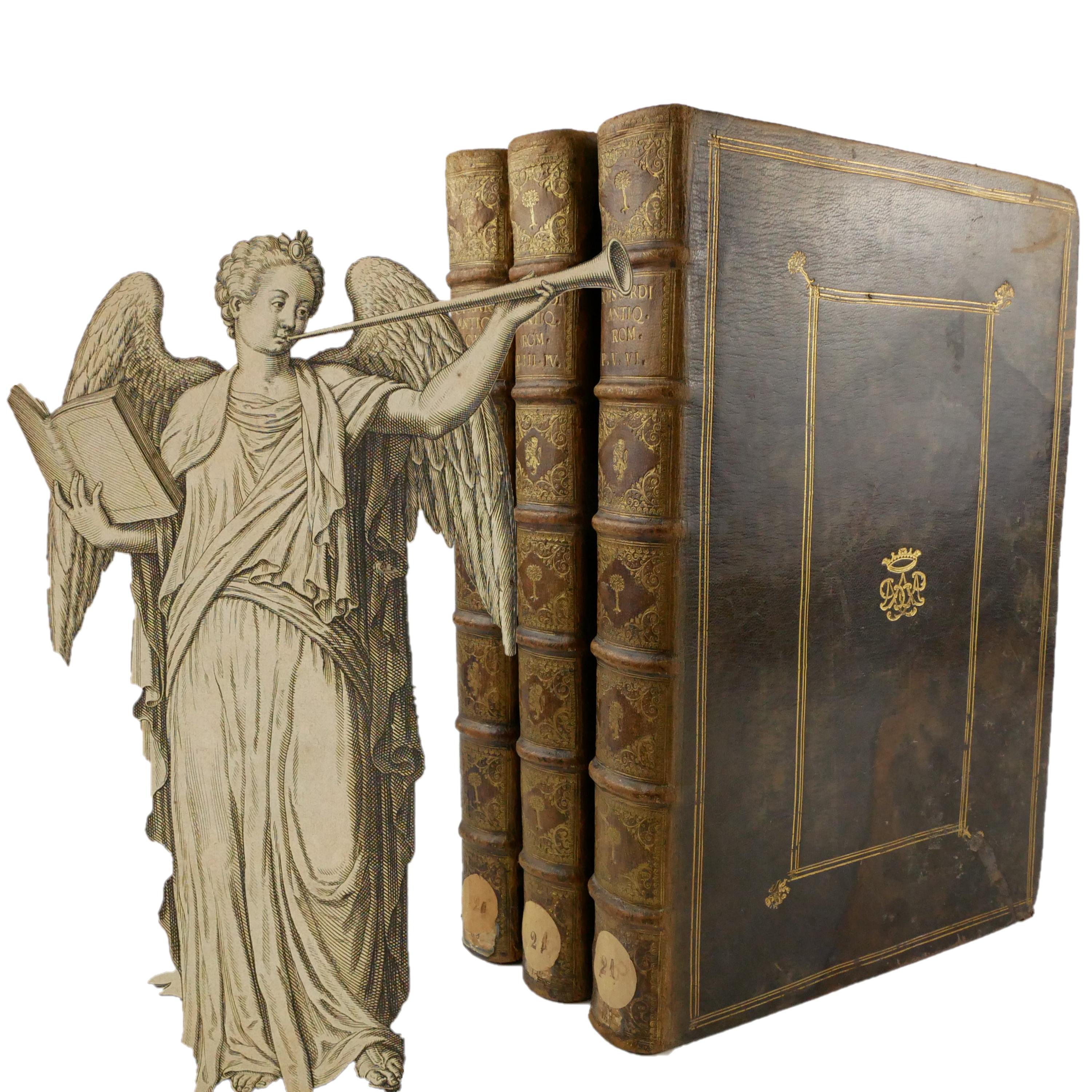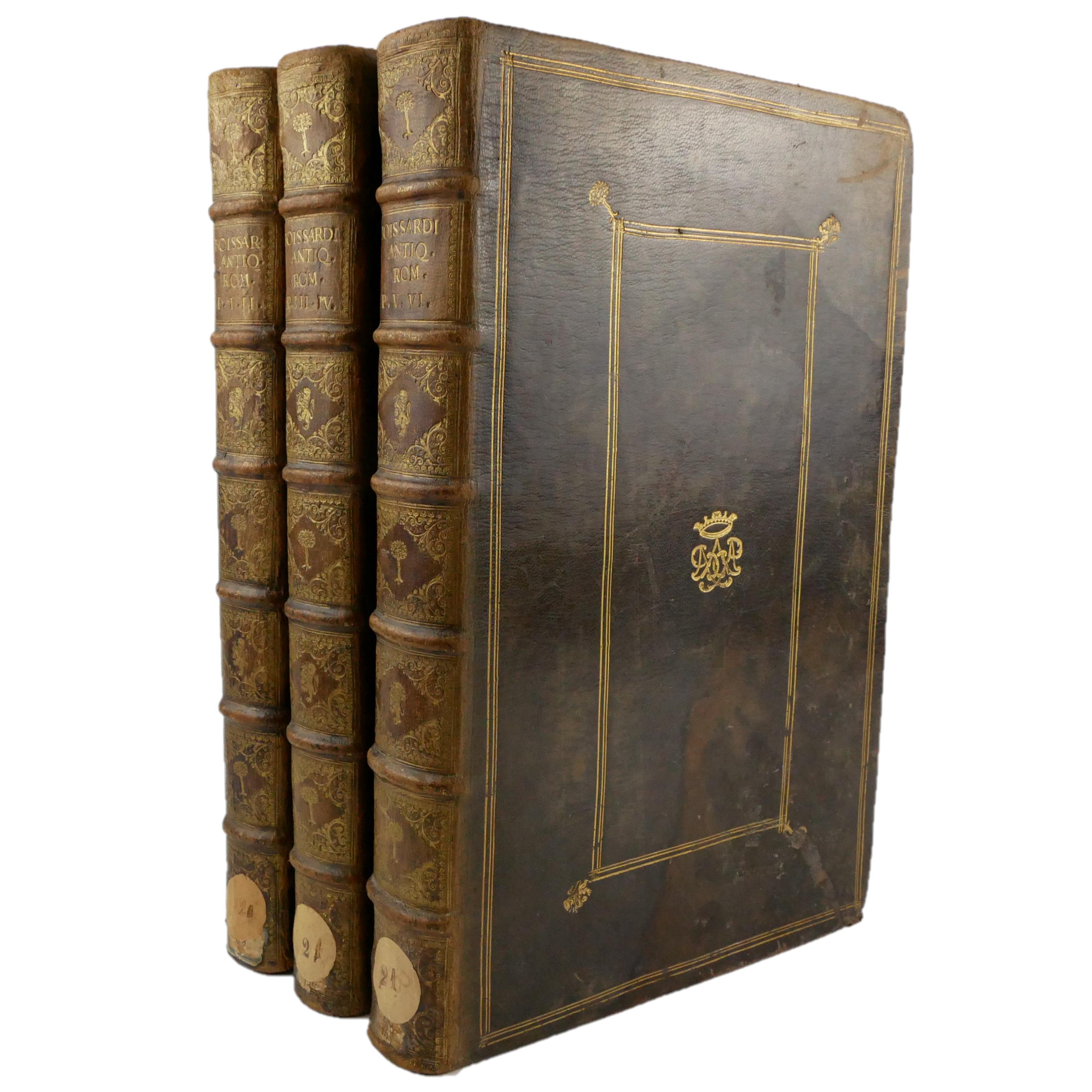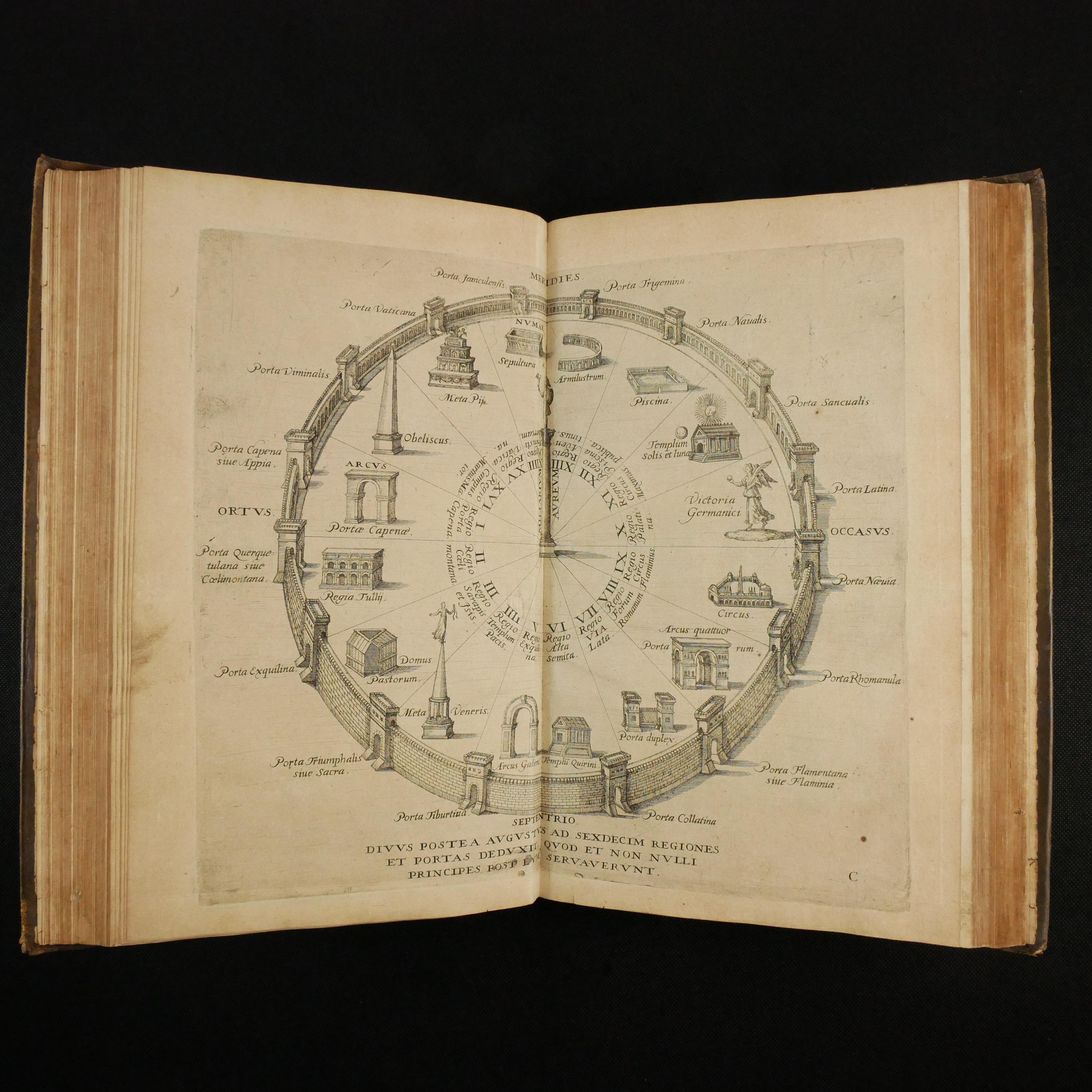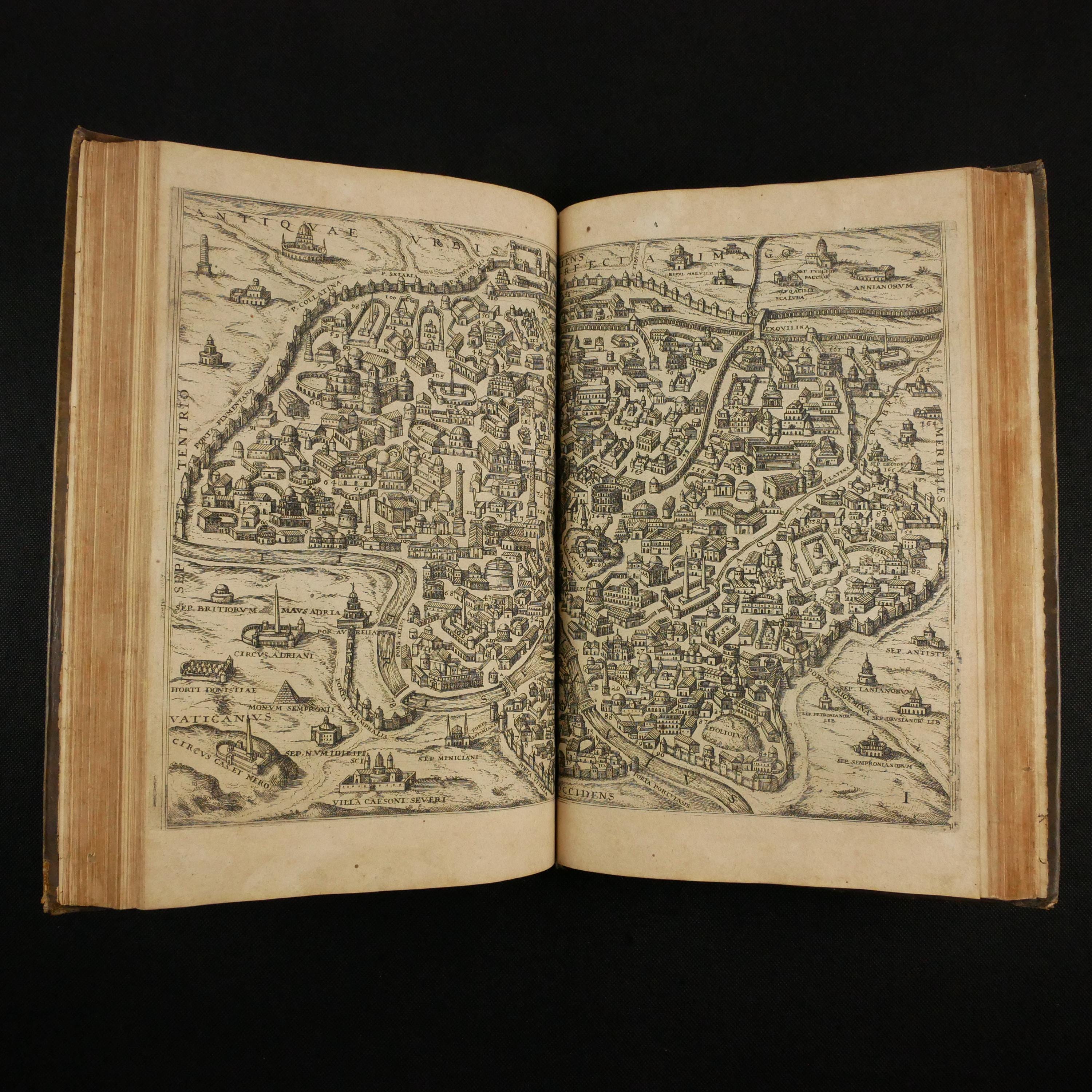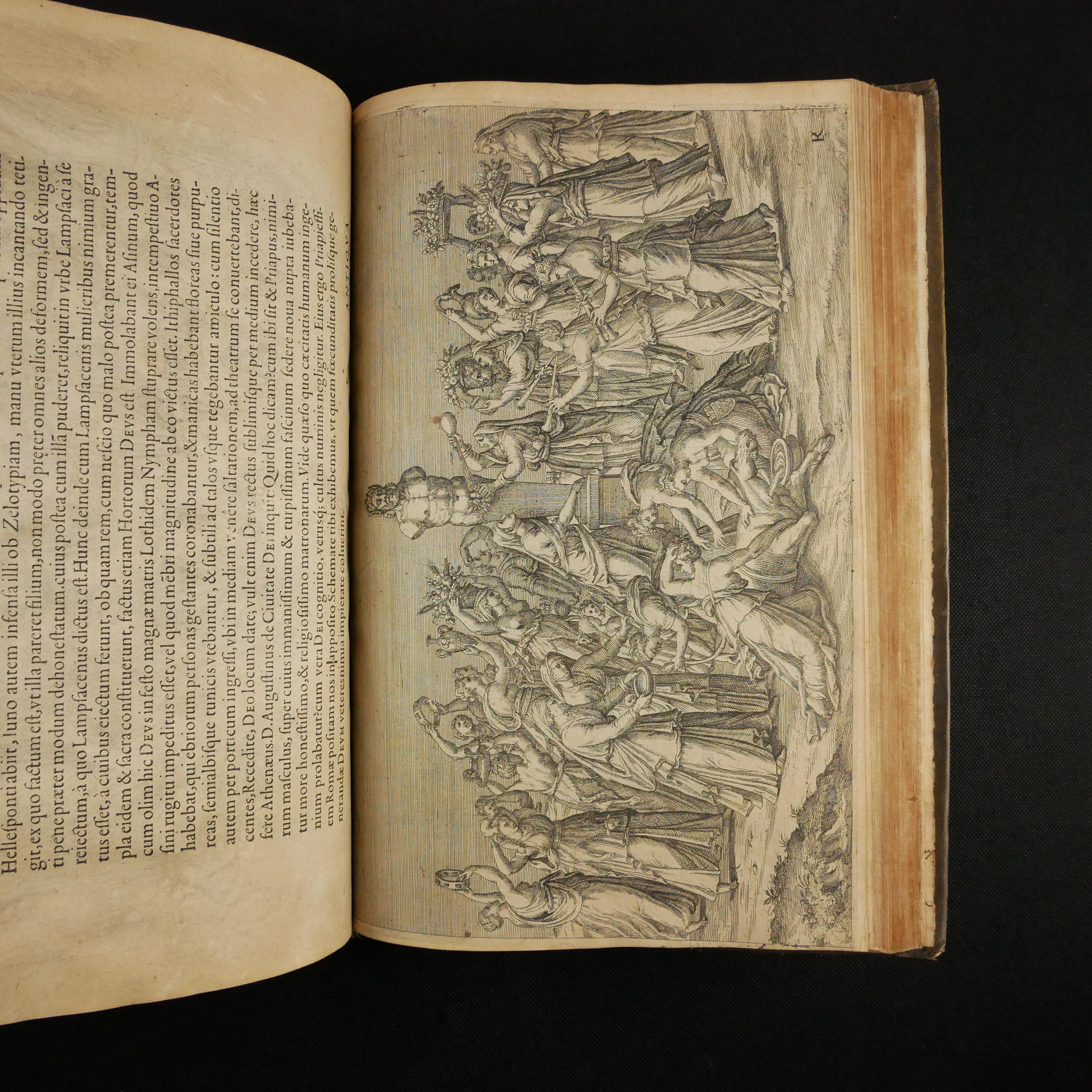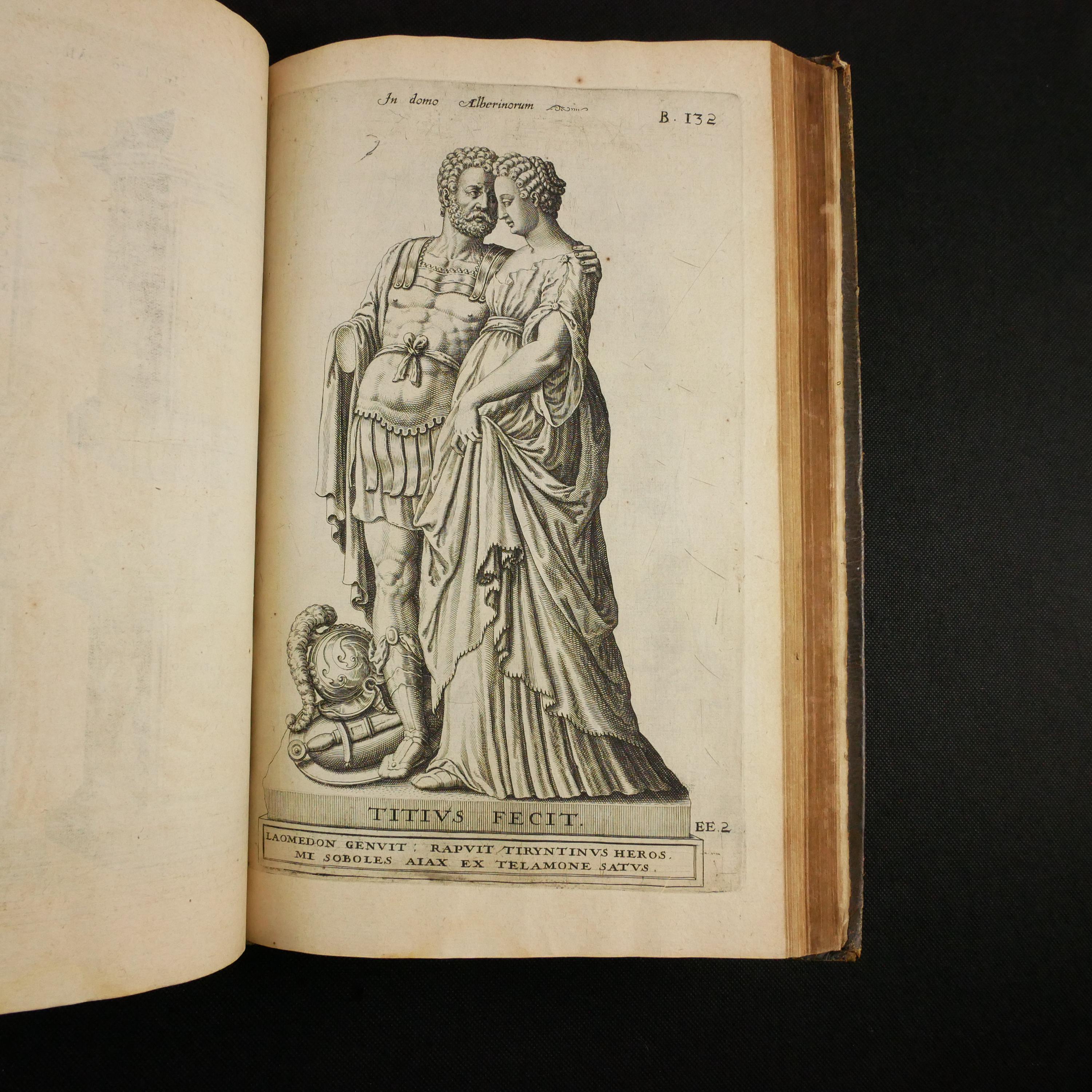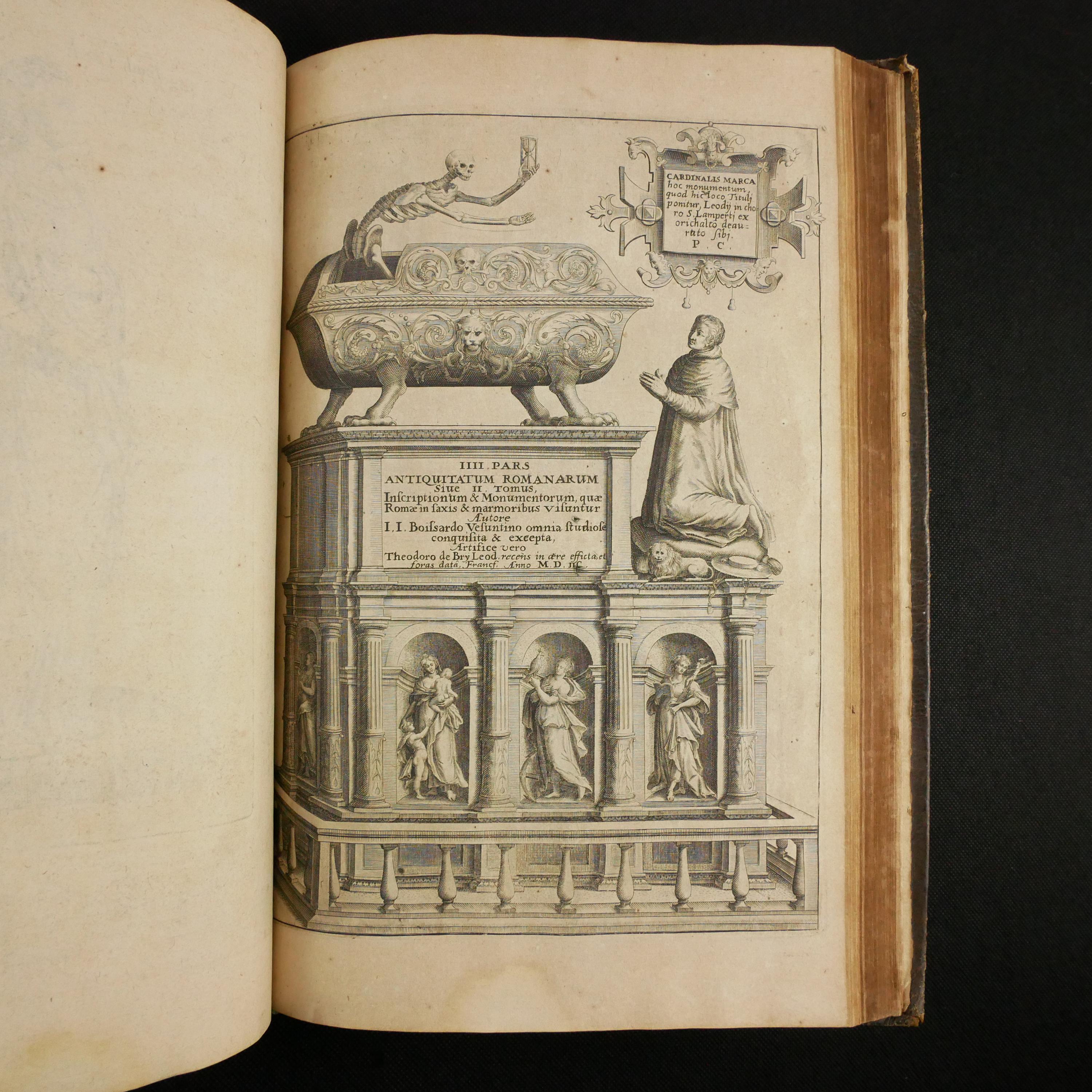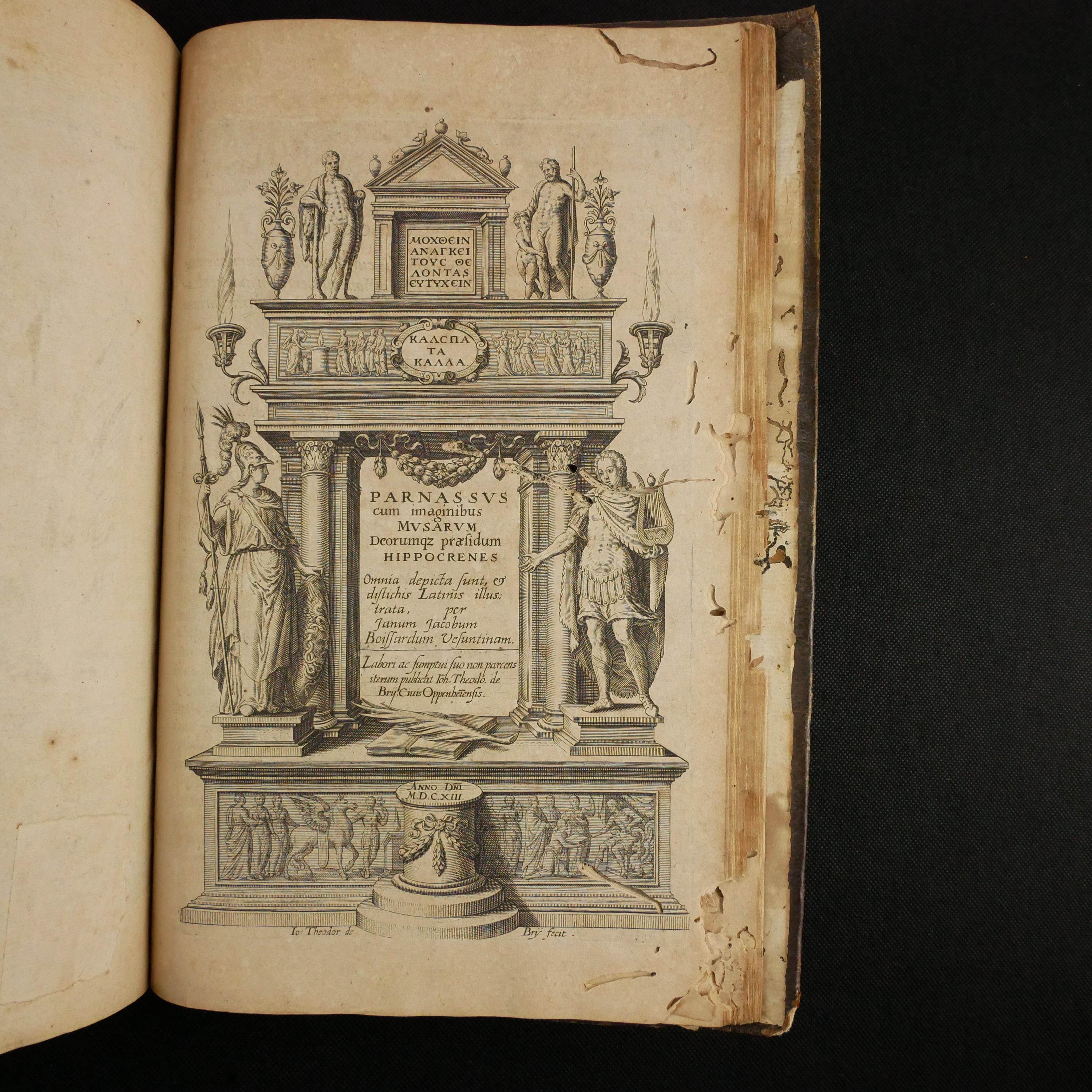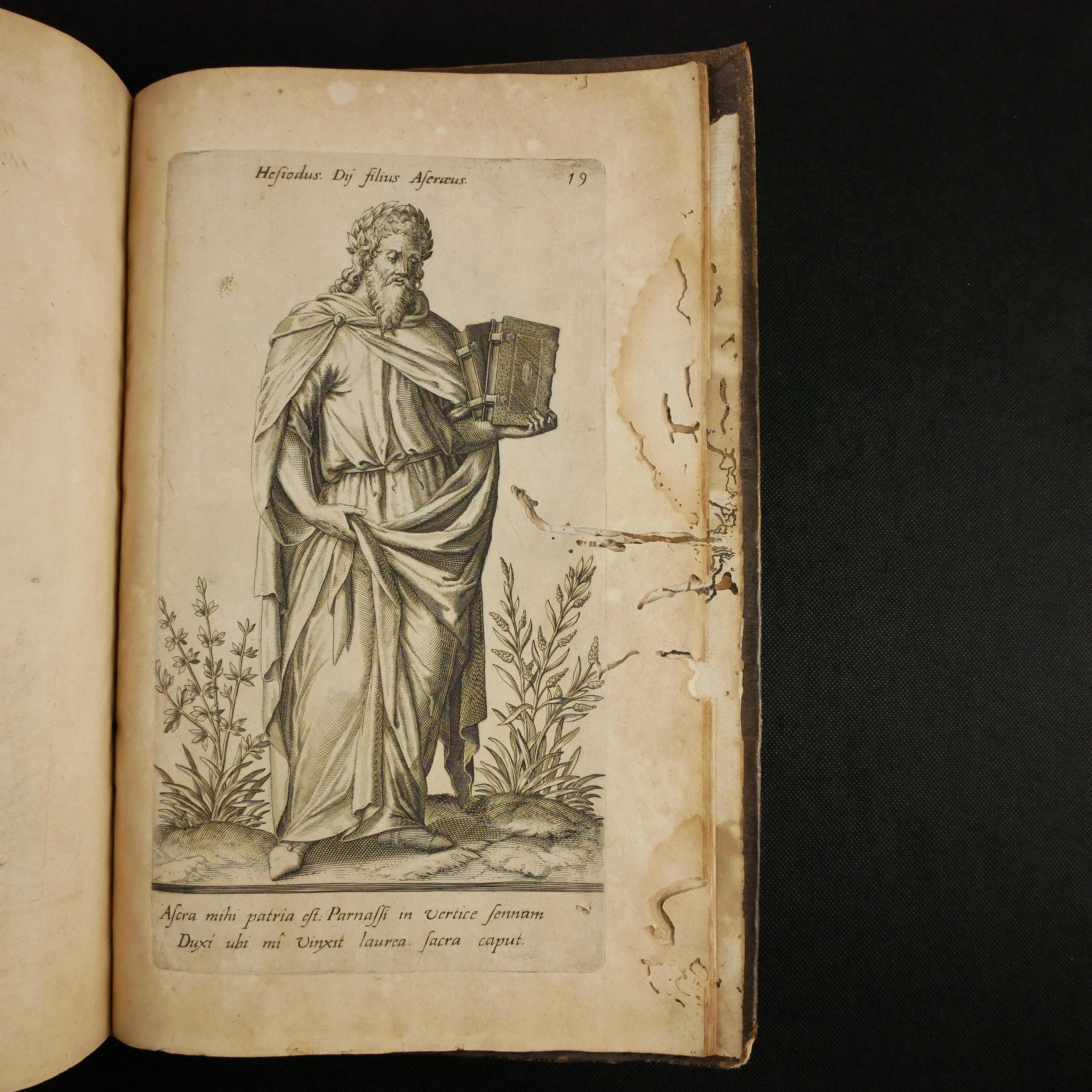1597-1602 Urbis Topographiae and 1613 Parnassus cum Imaginibus Musarum, Boissard. Illustrated by Theodore de Bry.
$6,999.99
A rare 1613 Parnassus cum Imaginibus Musarum is bound at the rear of this 1597-1602 Romanae Urbis Typographiae (in six books).
In Urbis Typographiae, through six books (bound into three volumes), Boissard captures the antiquities of Ancient Rome, the volumes richly illustrated by de Bry. This set is missing the first books title page, two maps, an index and a subscriber's page. I did print the missing maps, in simple facsimile (not to scale) on acid-free, laid artist's paper.
Regarding the 1613 Parnassus, it is a collection of 25 engravings capturing mythological god's, philosophers, etc. which inhabited Parnaussus. Rare Book Hub has no record of the 1613 edition being sold. USTC and OCLC only record three copies in the world's libraries (see more below). The title page states that the 1613 edition was executed by the heirs of de Bry.
Of the three Parnassus editions, Rare Book Hub only records three auction offerings of the 1601 edition; once in 1986 at Sothebys, in a sammelband now offered for sale by Robin Halwas, once in 1934 and once in 1931 (both times offered by Sothebys). No auction records are found for the 1613 and 1627 edition.
Of all the editions (1601, 1613 and 1627), there are less than twenty copies recorded in the world's libraries (again, see below) and they are in the most prodigious of libraries. The Vatican holds two copies, as does Cambridge University (England) and the BNF of Paris. The Bodleian (Oxford) holds another copy.
Of the editions, the 1613 edition (the edition here offered for sale) is rarest.
About Boissard -
From the German wikipedia -
"Jean-Jacques Boissard led an eventful life and spent a large part of his time travelling. He gave up his theological studies in Germany and the Netherlands (Leuven), which he had initially taken up, out of dissatisfaction with his strict teacher and joined his uncle, the humanist and private teacher Hugues Babet (Hugo Babelus, 1474–1556). After crossing a large part of Germany, he came to Italy, where he stayed for several years and often got into economic difficulties. In Rome, he spent considerable time in the entourage of Cardinal Antonio Carafa, developed a taste for antiquities and began to collect artifacts from the ancient city and its surroundings."
"He then visited the islands of the Greek archipelago with the intention of travelling to Greece, but a serious illness forced him to return to Rome. Here he resumed his favourite pastime with great zeal, completed his collection of artefacts and returned to France."
"From 1583 he stayed in Metz more permanently and in 1587 married Marie Aubry, the daughter of his previous printer and publisher Jean Aubry. Later, however, his publications brought him more and more into contact with German publishers and especially with Theodor de Bry."
From 1597 to 1602 Topographia urbis Romae was completed as six parts in three volumes, with illustrations by Theodor de Bry, the first two parts dedicated to Roman topography and the remaining four to inscriptions and monuments.
About Parnassus... -
Parnassus was another collaboration between Boissard and de Bry, with text from Boissard, regarding the Muses of Parnassus, and 25 plates of representation by de Bry.
Provenance Discussion -
The binding is of interest, and I haven't been able to find an exactly matching binding.
The monogram is very similar to some monograms used by Queen Anne (see the Toronto British Armorial Library Queen Anne Stamp 12 and 14, the 1706 revenue stamp of Queen Anne, the 1701 Book of Common Prayer in the Royal Collection Trust and the spine of the 1700 Book of Common Prayer in the Royal Collection Trust).
That being said, none of the Queen Anne binding stamps are an exact match. And, despite checking the usual sources, I could not find the stamps of the tree and a lion holding a (money?) bag.
Also, the crown over the monogram isn't impressive enough to be a queen.
It could be this was a Princess Anne book, bound before she became queen, but this is simply wild speculation since I couldn't find a matching binding.
Regardless, it's a rich and interesting binding that deserves more scholarship.
The last volume does have a "grand seminaire" stamp on the title page, so the books may have been the gift of whoever's monogram decorates the boards.
Bibliographic Details For Urbis Typographiae-
Universal Short Title Catalogue (USTC) number 2215498, only two copies listed in USTC (both in Germany) for this number. There may be another USTC listing I'm not finding.
Worldcat OCLC number 21703788; five copies listed - Univ. of Chicago, Harvard, Cambridge (England), U. of Otago (NZ) and Berkeley.
Brunet lists this work on page 1069, in the 1860 edition of the Manuel du Libraire Volume 1.
Bibliographic Details For 1613 Parnassus -
19 engravings by de Bry, and six by Robert Boissard.
This edition not mentioned by Brunet, only the 1st and 3rd edition.
Title page states it is a reprint executed by the heirs of De Bry.
USTC Catalogue number 2068368; 2 copies listed in the world's libraries. One at Cambridge (England) and one at the Herzog August Bibliothek in Germany.
A worldcat entry notes a copy bound into another volume, entry 18931014; this book at the Chicago Botanic Garden library.
Of the 1601 edition, from which the 1613 edition was printed (with a revised title page), USTC (2013087) entry lists five copies, one in the BNF of Paris, Landesbibliothek, Herzog August Bibliothek, the Vatican, and Cambridge University (England). Worldcat adds one copy (457090162) at the Paris Bibliotheque Mazarine and one copy (465890180) at the Royal Danish Library. Haith Trust reveals that the Getty Research Institute holds one copy. Robin Halwas has a copy in a sammelband they are selling; Halwas found a copy in the New York Library as well, and possibly other copies in Germany (although Germany has a habit of claiming one book across many libraries).
Brunet lists the 1601 and 1627 editions on page 1068, in the 1860 edition of the Manuel du Libraire Volume 1.
Of the 1627 edition, which was retitled "Parnassus Biceps" (an eight additional plates added), USTC records four copies; the Vatican, BNF Paris, Saxon State Library, and the Bodleian (Oxford).
Of all editions, less than 20 copies recorded, the 1613 edition being the rarest.
Physical Attributes -
Two works, in three volumes. Each volume measures approx. 32 x 20.5 cm. The set is 12 cm wide. Either olive, or a faded black, morocco leather. Boards in the Cambridge style, with triple gilt fillet frame and gilt corner tools of trees and lions holding a bag; at the central of each board a crowned monogram. Spines with six raised bands; six compartments with alternating central tools of lions holding a bag and trees surrounded by dentelle and floral sprays, one compartment with the title in gilt. All edges gilt. White and blue double-endbands.
Richly illustrated by de Bry (mostly), among others.
Collation:
Tome 1
Pars i
Missing *1, the first parts title page; supplied in facsimile printed on acid-free laid artist paper.
Collation - *2-4, **4, Two leaf map of Italia Antiqua, A-T4, V6 (V6 blank).
The Italia Antiqua is a different variant than that in the Getty copy; it's Philipp Cluver's edition, which was in a later 17th century book. It is on laid paper, with a jester watermark.
Pages – xiv (of xvi), two leaf map of Italia Antiqua, 163 (1), 1 blank
Pars ii
Collation - :4, 2*-3*4, A-C each two leaves, D gathering is missing, E-H4, (signatures not in order, in each gathering, but I found four for each) “I” gathering seems to have 5, but then the N gathering has 3, making up for it (Brunet notes the N3). K and M have four leaves. O-Z4. Aa-Kk4, Ll3 (finis). No Ll4, per Brunet (and a copy online), missing a plate to be inserted at L4, “Castellum”.
The key, at the bottom of the I gathering map, has been trimmed away.
Pages – iv, 1-18 (3*4), leaves of plates, 55 (O1)-211, Index 1-11
Tome 2
Pars iii
Collation - Cross4, A4, B-D6, F-Z4, AA-II4.
Pages – xxii, 1-150
Per Brunet, missing the rear index and subscription leaf.
Pars iv
Collation – Title1, :2, “)(“1 (so four leaves encompass before A1), A-Z4, AA-GG4
Pages – Title leaf - ii, 1-149 (1) – numbering printed on pages begins at B2r with “16”. Brunet mentions 9 preliminary pages, which equates to that first set of four leaves, A4, and B1.
Tome 3
Pars v
Collation - *4, **6, A-Z4, Aa-Hh4, Ii6
Pages – xx, one unnumbered plate, 1-129 numbered plates (1)
Pars vi
Collation – ):(4, A-F6, plates numbered 1-108, leaf of Raphael, two leaves of Roman wolf mother, leaves numbered 109-146.
Pages – viii, 1-47 (1), 1-108, three unnumbered leaves, 109-146.
Parnassus
Collation - *4, **6, plates numbered 1-25, one blank leaf
Pages – xx, 1-25, a blank leaf. The last blank leaf does have the same watermark as the plate “23”, assuring it is from the original printing; it is a vertical watermark, that looks like “46m” with a vertical line through it. Brunet didn’t mention the last blank leaf.
Note that in the pars vi, the Raphael plate and the Roman wolf mother plates are bound-in at an odd place. In other copies I see them here and there. Brunet found only one of them in Pars vi.
Here are Brunet’s entries (Urbis and Parnassus), translated into English –
This first edition, better printed and on better paper than the second, still has the advantage of containing the first proofs. Here is the description:
Pars I, 1597, Topographia romanæ urbis Jano Boissardo, author, and Onuphrii Panvinii descriptio XIV regionum urbis, VIII ff. prelim., 163 pp., and a map.
II, 1597, Topographia antiquæ urbis Romæ, by J.-B. Marliani, title and 2 portraits. grav., 18 pp., one part not numbered, under the signatures A - N3, the signs A - C, I and L4 are occupied by double pls.; there are also 33 single pls., and the text is composed of 39 pp.), then pages 55-211, and 11 ff. numbered, sign. O - LL4. –
III, De antiq. urbis Romæ situ et origine, and Valerius Probus de notis antiquar. literarum, 11 ff. prel. 42 pages and 108 pls. numbered from 43 to 150, 11 pp. for the index and 1 f. for the subscription. –
IV, 1598, Antiquitatum romanar. , sive II tomus, inscriptionum et monumentorum quæ Roma in saxis et marmoribus visuntur (de funeribus, et de apotheosi), 9. prel. , pages 16 to 52 and 96 pl. rated from 53 to 149 (the 125 still inanque).
V, 1600, sive III tomus inscriptionum, etc. , 10 ff. prel. , 1 pl. unencrypted and 129 pl. encrypted.
VI, 1602, sive IIII tomus inscriptionum, etc. , Gyraldus de sepulchris et de vario sepeliendi ritu, 4 ff. prelim. , 47 pages, 146 pl. encrypted and one unencrypted.
Brunet on Parnassus -
in - fol . of 8 ff . not numbered , plus the title and the portrait . engrav . and 25 pl . by J.-Th. de Bry .
Condition -
Bindings worn, with edge, corner wear (and bumping) and rubbing to boards, with some scrapes and fading to leather. Tome 1 with a moisture mark at rear board bottom gutter corner. Spines sunned (faded) with library shelf marks at bottom. 1” Crack at head of spine tome 1. One worm hole in rear board of first tome. Second tome only has a small moisture mark at rear board. Volume three shows the moisture mark mostly on the front board (and its pastedown).
Some worming throughout all; mostly in margins but sometimes in text. Some toning throughout all (some pages more than others), with occasional fox spots, thumbs, candle ember marks, dog-eared pages, page edge tear, ink spot, etc. All volumes with some random ex-library shelfmarks on the front endpapers.
Tome 1 flyleaf torn at gutter. Pars 1 missing title page, *1. Top corner 67/68 clipped, no text affected.
Pars II plates A-C mounted. No D plate (a map and description of Rome, showing the river). Per Brunet (and a copy online, this copy missing a plate to be inserted at L4, “Castellum”). Par ii, M3 to end some worming. Ee to rear, water stain from bottom. Missing colophon of printer (last leaf).
Tome 2, Pars iii – flyleaf ripped at gutter. Library stamp scraped off title page, ex libris plate removed from rear leaving toning.
Pars iv, water stain from bottom from F signature to rear.
Tome 3, no flyleaf. More toning to this tome, and more worming to the rear of the tome (pars vi, 140 to end). Pars v, two library stamps on title page. Chip to A2 fore-edge, no printing affected. Chip to bottom corner X1.
Pars vi, circle drawn as recess in grave on plates 33, 34, 42, 44, 45, 46, 48, 49; square on 41.
Parnassus wormed (see pics).
Missing pars i title page. One pars i map is a 17th century replacement, Italia Antiqua.
Missing two maps in pars ii; one of Rome with the River running through it (pars ii, D gathering, labelled "Occasus") and one of a double page map at pars ii, L4 (Novissima Urbis Romae...). I did print these two out, on acid-free laid artist paper, (not to scale) as the simplest of facsimiles so that you may have the full context, from scanned copies (not perfect).
Pars iii is missing the rear index and subscribers page.
Shipping from United States
Processing time
1-2 business days
Customs and import taxes
Buyers are responsible for any customs and import taxes that may apply. I'm not responsible for delays due to customs.
Payment Options
Returns & Exchanges
I gladly accept returns
Just contact me within: 7 days of delivery
Ship items back to me within: 14 days of delivery
I don't accept exchanges or cancellations
But please contact me if you have any problems with your order.
Conditions of return
Buyers are responsible for return shipping costs. If the item is not returned in its original condition, the buyer is responsible for any loss in value.
Privacy policy
We do not collect any private information. For billing, Etsy provides the service. We only receive notice that payment was made. The shipping address is provided to us by Etsy, based on what they buyer submitted during check-out. We do not store these addresses. That is the extent of the information that we receive during a transaction.
